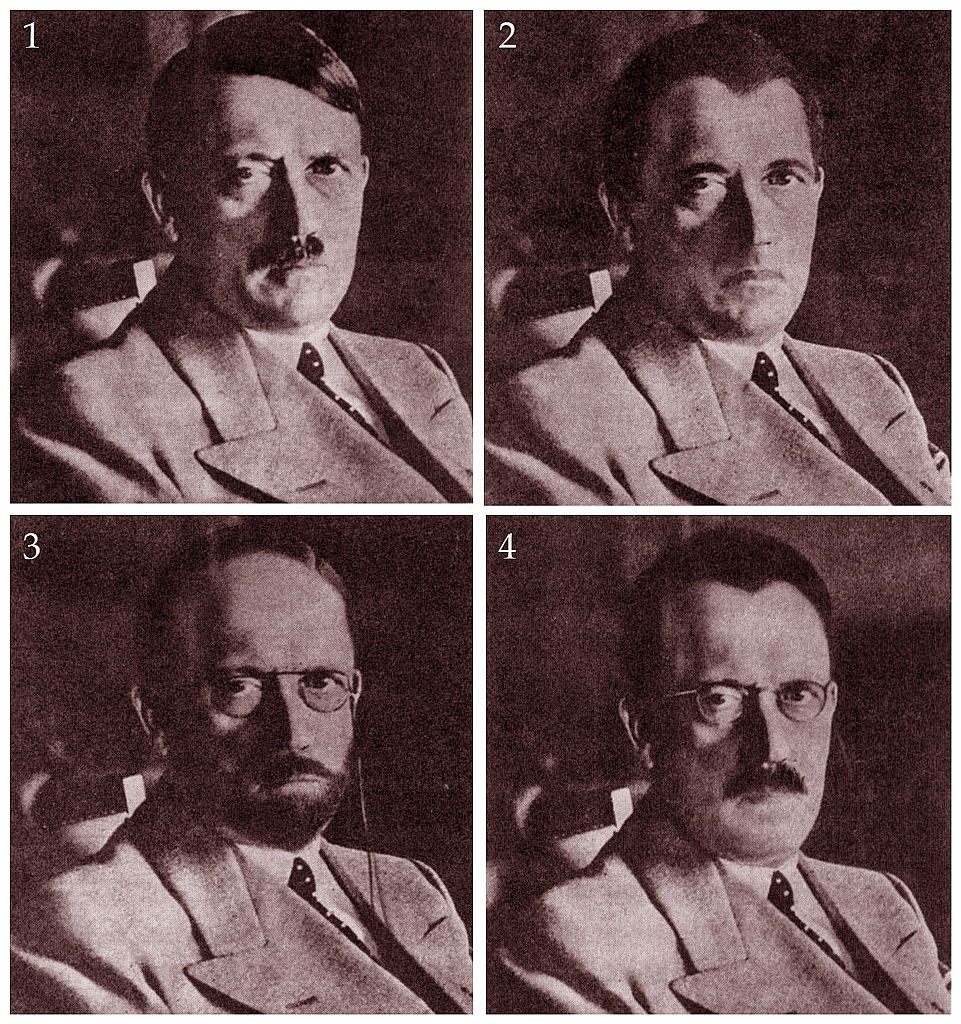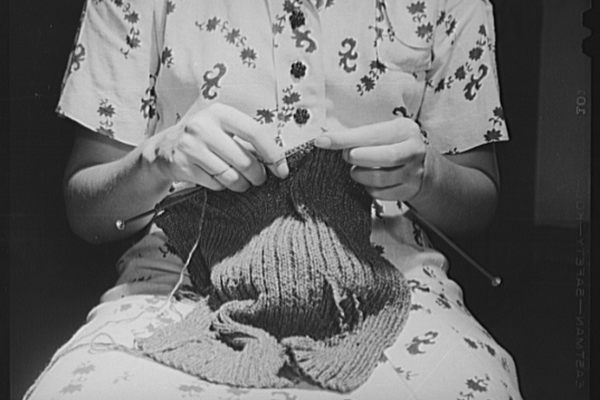The Wildly Misunderstood Photos of Hitler in Disguise
The legend of how a make-up artist reimagined the German dictator blossomed in the internet age.
By 1944, the face of Nazi party leader Adolf Hitler had stared out at the public from newspapers and newsreels for years. His unmistakable mustache, plastered hair and manic gaze were burned into the brains of the public (where they remain). There was a flipside, also, to that iconic visage—the fear that the genocidal dictator could wipe his most recognizable features away, and fade into the crowd.
It was this fear that led a New York makeup artist named Eddie Senz to give Hitler a makeunder. In a series of altered photographs, reportedly created for the U.S. government, Hitler sports a beard. He has glasses, is bald, and parts his hair differently. The images are strange, otherworldly, even darkly funny—there’s something satisfying about seeing the man stripped of the things that lend his face import.
The story is that Senz was called upon by his country to carry out cosmetic intelligence, providing the feds with a lookbook of disguises that would enable them to nab Hitler if he shed the mustache and made a run for it. This tale surfaced in print through the years in outlets from Der Spiegel, to the Associated Press to the Times Picayune to Austraila’s Herald Sun. It enjoyed a second life online, where it was reported by the Daily Mail, Business Insider and found its way onto Reddit and other sites. But this version of events is not quite the truth.
Born in 1899, Senz was a legacy makeup man.
“I came by my work honestly,” Senz told The New York Times in 1961. “My father was make-up director for the Metropolitan Opera House and I was practically raised backstage.”
Senz went to Hollywood, where he tended the blossoming stars of “talkies,” doing makeup on the sets of Paramount, Fox and Warner Brothers.
His work with celebrities like Rudolph Valentino helped launch his career as a go-to authority on beauty, dispensing tutorials and tips in magazines and newspapers.

Towards the end of the war, there was a fear that Hitler would flee in a disguise. (Photo: Universal History Archive/Getty Images)
At the same time Senz was anointing starlets with powder and lipstick, World War II was grinding to an end. The Allies invaded France on D-Day, June, 6, 1944, and proceeded to push back German forces in Europe. With defeat on the horizon, people began speculating about how or if Hitler would meet his demise. The idea that he would disguise himself and escape retribution by fleeing abroad was widespread. (This fear was validated by history; plenty of Nazis successfully moved abroad and many were even assisted by the United States government in relocation.)
The scenarios were alarming. “Adolf Hitler has had his face lifted, his whiskers removed, his nose changed by facial surgery, his hair returned to its natural white for a man of his age, and parted the normal way on the left side,” wrote the Berlin bureau chief of the Associated Press in a 1944 article.
The same year, the New York Times published a story by German journalist Victor Schiff that also imagined a world where Hitler altered his appearance to dodge authorities. “Can you imagine how Adolf Hitler would look without his mustache and his dark lock, his hair cut short and dyed fair or ginger or white, and wearing horn-rimmed glasses and perhaps a bowler hat?” Times readers didn’t need to use their imagination, because the paper helpfully published images of Hitler in various costumes.
“These changes are illustrated above from suggestions by Eddie Senz of New York, make-up expert for the screen, stage and opera,” read the caption. “According to Mr. Senz, the hardest feature to hide is Hitler’s eyes—which he says “are the most remarkable I have ever seen.””
This could have been the end of it. Upon his death in 1973 Senz would be remembered for his work on stage and screen, not the unusual series of images that appeared in 1944.
But the U.S. government had taken note. The Office of Strategic Services—or OSS, a government agency that preceded the CIA—kept tabs on the news, and someone clipped the article and filed it away. Decades later, the internet would help resurrect the photos and Senz. The records of the OSS were declassified and made available to researchers; eventually several of them were published online through the National Archives and Records Administration.
The first fresh mention of the Senz photos appeared in a short article in Der Spiegel in 1998.
“The US Office of Strategic Services (OSS) wanted to be prepared for anything and instructed New York artist Eddie Senz” to create the images, the story reported. The story does not specify what document the images were discovered in. This triggered a flood of follow-up stories; several newspapers reprinted the images and similar stories. In 2012, they resurfaced online and the legend grew: The photos were distributed to officers abroad so they could hunt for Hitler, the photos were created on D-Day, they were distributed before the D-Day invasion, the photos had never before been seen until Der Spiegel unearthed them in the 90s.
The last bit is the easiest to debunk; the images obviously appeared in The New York Times in 1944. The National Archives and Record Administration confirmed via email that they credit to the images to the newspaper. According to official records, the OSS made a habit of accruing photographs of prominent people, often from commercial sources. The Senz series is stored in a box along with images of photographs of military and civilian figures from over seventy-five countries, including Josef Stalin and Mao Tse Tung.
It seems most likely that it was the New York Times that commissioned the images from one of the day’s foremost experts on faces. Since then, thanks to the internet and an insatiable hunger for World War II narratives, the story has taken on a Hollywood sheen; Senz is the glamorous makeup man called upon by the most secretive forces of the United States government to play a role in bringing a monster to justice.
After the Hitler affair, Senz continued to work with American stars. He opened a bustling salon in Manhattan, styled Broadway stars, and beautified the political elite, including first lady Claudia Alta “Lady Bird” Johnson and her daughters. (In a truly bizarre phone conversation—which you can listen to here—president Lyndon B. Johnson exhorts Senz to travel to Washington D.C. to tend to his family and staff for very little pay. “All right, now I’m a poor man, and I don’t make much money, but I got a wife and a couple of daughters, and four or five people that run around with me, and I like the way you make them look…” says Johnson. At this time, Johnson was estimated to be worth around eight figures.)
It’s hard to imagine, though, that Senz would easily forget the affair. Prior to Hitler’s death in 1945, people lived in fear that he would escape. After his death, they refused to believe it had happened.

Further disguises. (Photo: Public Domain)
For years, the FBI was flooded with news of Hitler sightings, some of which were investigated. He was spotted in a cafeteria in Los Angeles. He was living in Wisconsin, where he acted deranged and played the violin. He was a communist in Philadelphia; he lived in Miami and had plastic surgery. He was in the Soviet Union, Argentina and Denmark. Even today, people refuse to believe that Hitler perished in a bunker by his own hand in April 1945; there are websites and books devoted to telling the truth about the dictator’s escape to Argentina and other lands. On some of these sites you’ll find the images Senz helped create, proffered as proof that the United States government knew Hitler was on the run and in disguise.
Hitler’s death is unsatisfying; he was never held accountable before the world. Maybe this is why people felt compelled to tell stories about his survival. If he had lived, it meant he could be hunted down and punished.
In a 1973 obituary for Senz, The New York Times did not mention his role in redesigning Hitler, although they included a quote from a previous interview that seemed especially pertinent.
“Beauty is all a matter of concept,” he said in an interview. “In this country beauty generally means an oval Nordic sort of face. We’ve been brainwashed to think our standards are the only standards. Who are we to think we have a priority on beauty knowledge?”















Follow us on Twitter to get the latest on the world's hidden wonders.
Like us on Facebook to get the latest on the world's hidden wonders.
Follow us on Twitter Like us on Facebook